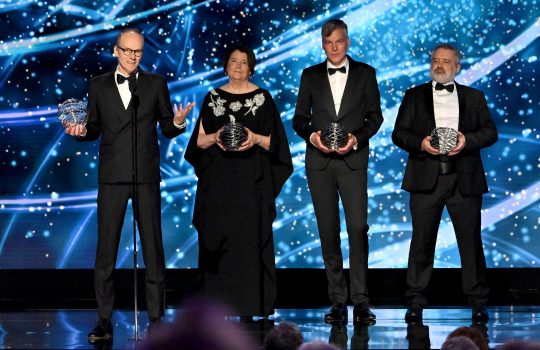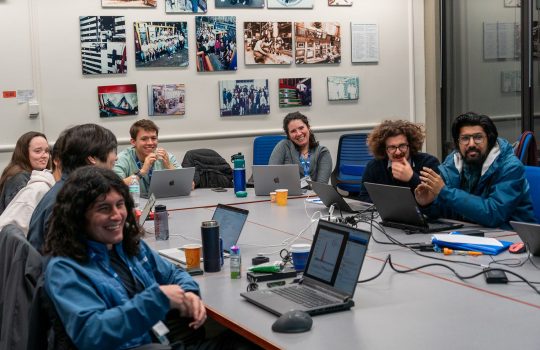After a quarter of a century of searching, physicists have discovered a rare particle decay that gives them an indirect way to test models of new physics.
Researchers on the CMS and LHCb collaborations at the Large Hadron Collider at CERN announced today at the EPS-HEP Conference in Stockholm, Sweden, that their findings agreed closely with the Standard Model of particle physics, ruling out several models that predict new particles.
In this result, physicists showed for the first time enough evidence to declare the discovery of a decay of a particle made up of two kinds of quarks—anti-bottom quarks and strange quarks—into a pair of particles called muons.
The U.S. Department of Energy’s Fermi National Accelerator Laboratory serves as the U.S. hub for more than 1,000 scientists and engineers who participate in the CMS experiment. DOE and the National Science Foundation support involvement by about 2,000 scientists and students from U.S. institutions in the LHC experiments CMS, ATLAS, LHCb and ALICE—the vast majority participating at their home institutions via a powerful broadband network that ships data from CERN.
“This is a victory for the Standard Model,” said CMS physicist Joel Butler of Fermi National Accelerator Laboratory. “But we know the Standard Model is incomplete, so we keep trying to find things that disagree with it.”
The Standard Model predicts that the particle, called B-sub-s, will decay into two muons very rarely, only three times in every billion decays . However, the Standard Model assumes that the only particles involved in the decay are the ones physicists already know. If other, unknown particles exist, they might interfere, either making the decay happen more frequently than predicted or effectively canceling the decay out.
“This is the place to look for new physics,” said LHCb physicist Sheldon Stone of Syracuse University. “Small deviations from the predicted rate would firmly establish the presence of new forces or particles.”
What scientists found was a decay that followed the Standard Model’s predictions almost to the letter. This spells trouble for several models, including a number of models within the theory of supersymmetry, which predicts that each known particle has an undiscovered partner particle.
But the hunters of new particles have not lost hope; the result leaves room for other models of physics beyond the Standard Model to be correct.
The analysis is a tour-de-force for the two LHC experiments, which needed to eliminate an enormous amount of background information generated by other particle decays that mimic the decay they were looking for. The latest results from searches at the ATLAS experiment at CERN and the CDF and DZero experiments at Fermilab are consistent with the results from the LHCb and CMS experiments.
As much as scientists can learn from measuring this decay, they can learn even more if they compare it to the decay of another particle made of quarks: B-sub-d, which is made of an anti-bottom quark and a down quark. A B-sub-d particle should decay even more rarely into a pair of muons than a B-sub-s particle. Physicists did not have enough data to make a definitive statement about this decay in this analysis, but their work shows that they will be able to gather evidence of it after the LHC restarts in 2015 at higher energy.
Background:
Information about the US participation in the LHC is available at http://www.uslhc.us. Follow US LHC on Twitter at http://twitter.com/uslhc.
Fermilab is America’s premier national laboratory for particle physics research. A U.S. Department of Energy Office of Science laboratory, Fermilab is located near Chicago, Illinois and operated under contract by the Fermi Research Alliance, LLC. Visit Fermilab’s website at http://www.fnal.gov and follow us on Twitter at @FermilabToday.
The DOE Office of Science is the single largest supporter of basic research in the physical sciences in the United States, and is working to address some of the most pressing challenges of our time. For more information, please visit http://science.energy.gov.
The National Science Foundation supports the research activities of U.S. university scientists and students on the ATLAS, CMS, LHCb, and ALICE experiments, as well as promoting the development of advanced computing innovations essential to address the data challenges posed by the LHC. For more information, please visit http://www.nsf.gov.
CERN, the European Organization for Nuclear Research, is the world’s leading laboratory for particle physics. It has its headquarters in Geneva, Switzerland. At present, its Member States are Austria, Belgium, Bulgaria, the Czech Republic, Denmark, Finland, France, Germany, Greece, Hungary, Italy, the Netherlands, Norway, Poland, Portugal, Slovakia, Spain, Sweden, Switzerland and the United Kingdom. Romania is a candidate for accession. Israel and Serbia are Associate Members in the pre-stage to Membership. India, Japan, the Russian Federation, the United States of America, Turkey, the European Commission and UNESCO have Observer status.



